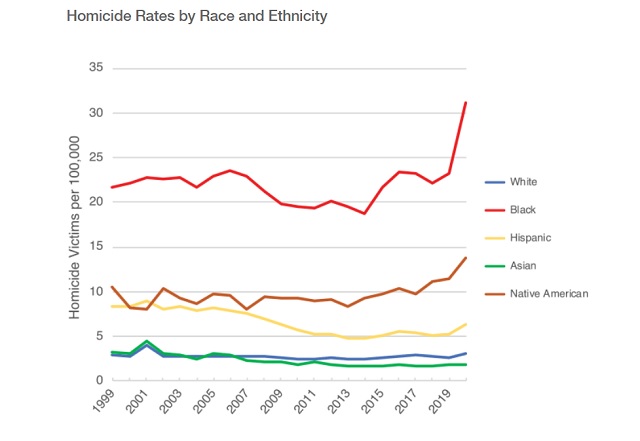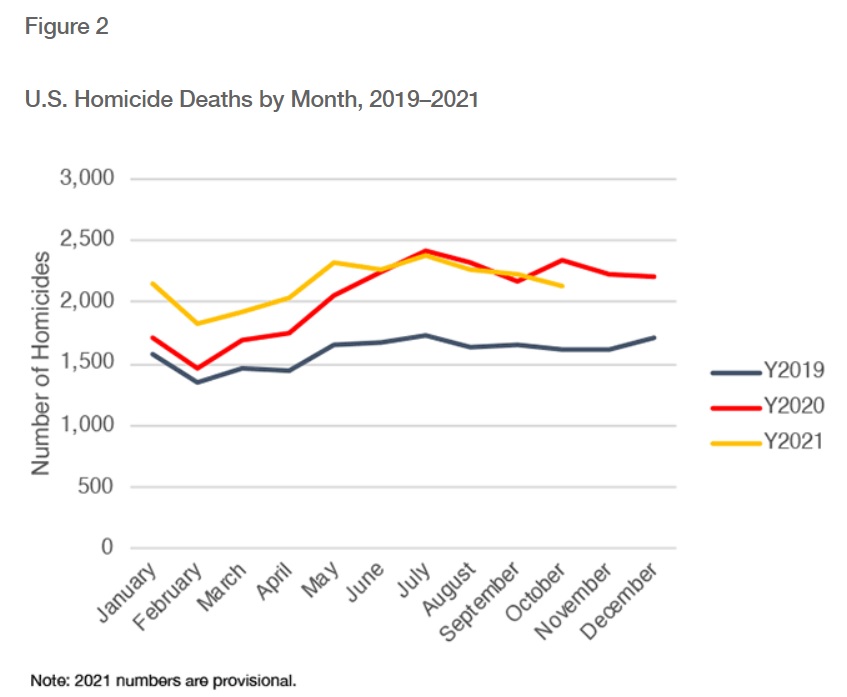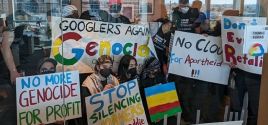
 The "success" of the Black Lives Matter movement resulted in a massive surge in black-on-black murders. The "success" of the Black Lives Matter movement resulted in a massive surge in black-on-black murders.
From The Manhattan Institute:
The national homicide rate spiked dramatically in 2020, a change obvious both in the CDC data and in the numbers from the FBI. [...]
Much attention has been paid to whether this increase was driven by the pandemic and lockdowns or—in an echo of the "Ferguson effect" debate from half a decade ago—by the summer protests and unrest, which could have led to depolicing. Homicide rates early in 2020 were slightly above 2019 levels—and the gap widened in March and April, before the murder of George Floyd in May—but violence truly exploded in the summer (Figure 2).

As the provisional data from the early months of 2021 show, the increase persisted beyond the end of the year. Another analysis, relying on data from big-city police departments, suggests that homicide rates in 2021 as a whole were even higher than they were in 2020.
Demographic Patterns
Homicides went up throughout the country, and for every major demographic group, in 2020, but they did not rise for everyone equally, as is clear when we break down the numbers by race, age, sex, urbanicity, and region of the country.
In making such comparisons, it’s important to understand two different ways of measuring such changes. Imagine that one group has a homicide rate of 1 per 100,000, while another group has a rate of 5 per 100,000. If those rates rise to 2 and 10, respectively, both doubled proportionally—but in terms of human costs, the second group was far more affected, with 5 extra deaths versus 1 for the group that started out with a lower rate.
This, tragically, is the pattern we see in the homicide data from 2020. Looking across various groups of Americans, there are relatively modest differences in terms of how much homicide increased proportionally; most of the increases fall in a range of about one-fifth to one-third. Far more dramatic, however, are the differences in the human toll of those increases, thanks to preexisting gaps in homicide rates that the 2020 spike exacerbated.
The racial and ethnic breakdown is perhaps most striking in this regard. Proportionally, homicide rates rose by about 34% for black Americans and about 19% percent for non-Hispanic whites: a notable, but not extreme, gap (Figure 3). But since the black homicide rate was already many times higher than the white one, this translated into 8 additional black deaths for every 100,000 population—an increase similar to the total homicide rate for the country as a whole—while the death rate for whites rose by only 0.5 per 100,000. (Recall that these numbers pertain to the homicide victims, not the killers, though American homicide is overwhelmingly intraracial.) It's remarkable how this isn't even a story. This breakdown has been out for a week yet garnered scant coverage.
As I reported earlier today, a recent YouGov poll found Americans' support for the BLM movement's goals has plummeted from 48 percent to 31 percent.
Follow InformationLiberation on Twitter, Facebook, Gab, Minds and Telegram.
|






 The "success" of the Black Lives Matter movement resulted in a massive surge in black-on-black murders.
The "success" of the Black Lives Matter movement resulted in a massive surge in black-on-black murders. 



